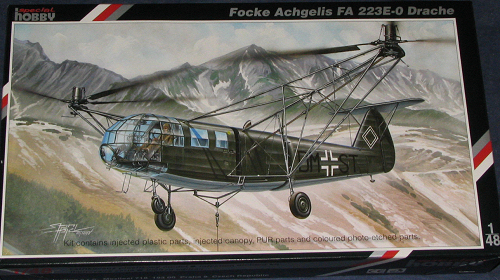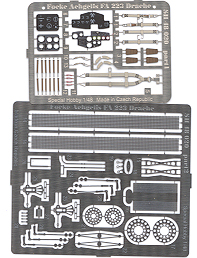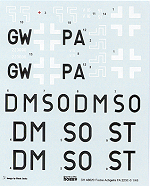
| KIT: | Special Hobby 1/48 Focke-Achgelis Fa-223 |
| KIT #: | 48020 |
| PRICE: | Around $45.00 MSRP |
| DECALS: | Four options |
| REVIEWER: | Scott Van Aken |
| NOTES: | Includes resin and photo etched parts |

| HISTORY |
When we think of 'German Wonder Weapons of WWII' (a History Channel production), rarely do helicopters get as much as a mention. Yet even when compared to the turbojet, the helicopter has changed our lives much more. From the ability to rescue people from impossible locales (for a fixed wing plane), to providing us with our daily traffic conditions (let's see an F-16 do that), helicopters are something that just about everyone sees on nearly a daily basis.
This all did not happen by accident.
In fact, both the US and Germany were hard at work developing something that would be successful. This something was actually developed from the autogiro of the 1930s and it all operates around the rotor-head and its ability to keep blades from smashing into parts of the aircraft. Eventually things were worked out and it was the German Flettner company that was able to provide the world with the first operational helicopter. With success under their belt, this technology was put into an even larger aircraft that could haul more than a pilot, observer and a light load.
Focke-Achgelis was tasked with designing a transport helo for Lufthansa and able to carry six passengers. Completed in 1939, there were the usual teething troubles, much of which were caused by flexing of the long side pylons. Eventually enough bracing was incorporated to prevent this from happening and in August 1940, it made its first free flight.
Seeing the obvious military application, 30 preproduction aircraft were ordered by the Luftwaffe. These were to be tested in various roles from standard transport to maritime patrol to recce and rescue. By 1942 the aircraft was ready for production and 100 were ordered along with the remaining preproduction planes. A most untimely bombing of the Focke-Achgelis factory resulted in the destruction of most of the few that had been produced and so production facilities had to be set up elsewhere. Once again production started only to be stopped by loss of the second factory. This caused further disruption as production was moved one more time and only one additional aircraft was completed. What this meant was that only 10 or 11 aircraft actually saw flight and most of those saw some operational use.
At the end of the war, the remaining aircraft were captured, with one making the first channel crossing by a helicopter on its way to England. Post war development was carried out in France and Czechoslovakia, though little use was made of them by the Czechs.
| THE KIT |
 Opening
the box presents the builder with struts, struts, and more struts. Much of this
kit is comprised of framework for the interior and for the rotor pylons. These
parts are commendably thin as is the fuselage and other parts. Detailing is
quite good and this extends to the fuselage, whose fabric representation is
commendably reserved though it still suffers somewhat from the 'hills and
valleys' syndrome. A few swipes with sandpaper will reduce this.
Opening
the box presents the builder with struts, struts, and more struts. Much of this
kit is comprised of framework for the interior and for the rotor pylons. These
parts are commendably thin as is the fuselage and other parts. Detailing is
quite good and this extends to the fuselage, whose fabric representation is
commendably reserved though it still suffers somewhat from the 'hills and
valleys' syndrome. A few swipes with sandpaper will reduce this.
Of the four plastic sprues, one is for rotors, one the
body and the others for the various frameworks. There are two photo etch frets
with the one for the instrument panels being colored and ready for use. This
includes the one with instruments painted on it.
 The others are for various
screens, oleo scissors, linkages and other bits. Resin is provided for rotor
bases a
The others are for various
screens, oleo scissors, linkages and other bits. Resin is provided for rotor
bases a nd rotor heads. The
transparencies are well molded and quite clear so you can see all the detail you
are going to put into the interior. Even with all these bits, you are still
going to have to stretch some sprue for the smallest bracings and some rigging
wires. The only optional bits are the choice between injected plastic and photo
etch on some smaller bits. While the P.E. is more prototypical in size, the
injected bits, while larger, are 3D.
nd rotor heads. The
transparencies are well molded and quite clear so you can see all the detail you
are going to put into the interior. Even with all these bits, you are still
going to have to stretch some sprue for the smallest bracings and some rigging
wires. The only optional bits are the choice between injected plastic and photo
etch on some smaller bits. While the P.E. is more prototypical in size, the
injected bits, while larger, are 3D.
Instructions are quite good, showing the various construction steps and the colors needed. Additional detail drawings are given where they are needed to assist with alignment. Markings are provided for four very similar aircraft; differing only by code letters. These are all RLM 71 over RLM 65 or overall RLM 02 with RLM 02 used for all the external bracings. Decals look to be well done with the usual split swastika so that some won't go on a rampage from seeing the complete symbol.
Oh yeah, this one is going to be a major tail sitter. Good luck finding any place for the weights.
| CONCLUSIONS |
As I rarely pay much attention to the 'what's coming' pages of magazines and such, this one was a pleasant surprise when I saw it. I've always been fascinated by early versions of aerial technology and this one fits right in. I should say that this is not a kit for beginners and that is as much due to all the framework and bracing as anything else. Even those just getting into the genre of short run kits (no matter how well done) should buy this one and put it aside for a bit until the skills are up to it.
Having said that, those of us who have done quite a few of these kits will be able to handle all the fiddling and fussing that is sure to come from this build. It is one that I'm going to make all efforts to sneak into the build schedule at the first opportunity.
| REFERENCES |
Kit instructions and my bulging cranium.
March 2006 If you would like your product reviewed fairly and quickly by a
site that has over 300,000 visitors a month, please
contact
me or see other details in the
Note to
Contributors.